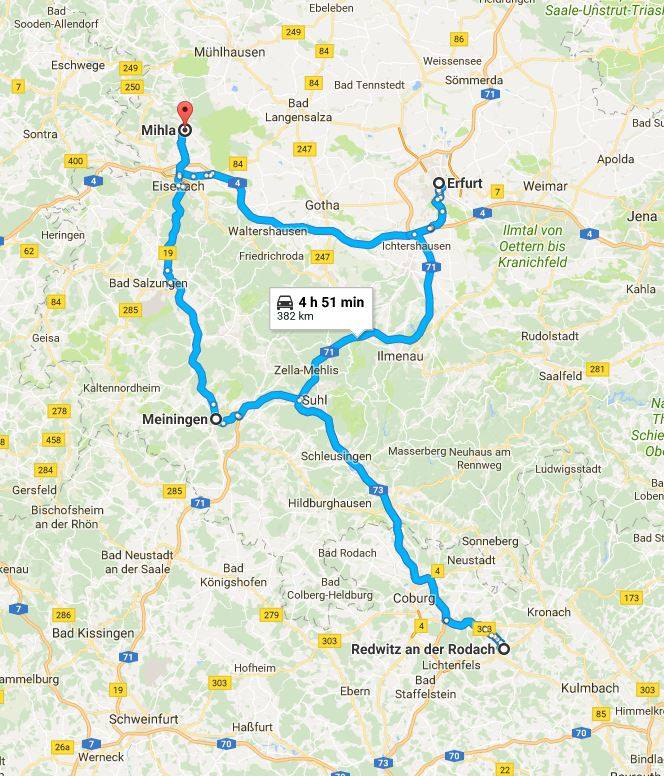38. Reporting on my June 2017 search for Weis(s)enborns: the third day, Wednesday 21 June.
Posted on Facebook on 12 July 2017. I again rose with the first day light. I had my breakfast at 6, when the sun appeared above the hills: two cups of Earl Grey tea and the three buns I had bought in the center of Gotha the previous day. I headed for the Staatliches Archiv in Erfurt. This time I drove to Eisenach and took highway 4, see the attached map. Erfurt is a much bigger city than Gotha, and I had to be in its very center, which abounds in oneway streets, streets-turned-pedestrian-area, many street cars and very few parking places. When I thought I was nearly there, stopped in an awkward place and stepped out of the car to check my map, a young lady stopped next to me, lowered her windscreen and asked if all was OK. I told her where I wanted to go and where I thought I was. She thought hard and then said "follow me, I believe I have seen a sign to the building you are looking for; I 'll drive ahead of you over there." I am glad she did. We drove in a U-shape around a few blocks and then she pointed me into a street of which I recognised the name. And ... it had one free parking spot, which I took immediately. I heaved a deep sigh and topped up my breakfast with two plums and two nectarines. The visitor's entrance to the archive was tucked away around yet another block, and accessible via a private car park. Inside the archive I wished I had gone first to the nearby Augustiner Kloster, where the Kirchliches Archiv is located. When I had made the appointment over the phone, the lady had said: "when you want to see the church registers: they are in the Kloster building, which you can see from here." That is true, but I now realised that the two archives have nothing to do with each other. In the large study room I was given one of the four reading machines and a film with a civil registration system on cards which contained data of persons who had lived in Erfurt in the period 1870 until 1930. In the morning I copied the key data on Weissenborns. I reached the letter K. I even printed a number of busy images which I couldn't decipher on the spot. When I asked to see the original card for a very unclear image, I was told that the card system itself had been destroyed and that all that was left was the film. At lunch time I walked over to the Augustiner Kloster to see if I could spend the afternoon studying the church registers of Erfurt and, in particular, of the village Marbach, to see if I could find out more about the ancestors of, amongst others, facebook friend Carol Weisenborn. Dr. Michael Ludscheidt, the curator and librarian, informed me that I could have an appointment in 6 weeks, as the one available film reader was fully booked up until then. He further mentioned that he had available the films of the church registers of over 100 towns and villages in north-west Thüringen - those which are not available in Eisenach -, for instance of the church registers of Mühlhausen - which I had seen on Monday - and Niederdorla and Seebach - which I would see on Thursday and Friday -. I had a warm lunch to lessen my disappointment. Until 4 o' clock I continued copying the data on the film in the Staatliches Archiv. Then I drove the 150 kilometers to Redwitz in north-Bayern (see the attached map) to pick up 4 hardly used wheels with tyres for a close friend's 12 year old Peugeot 403. Advertising on the internet can go a long way. On the way back I took the highway to Meiningen. When I turned onto road 19 to Eisenach, I noticed there were road works on the bridge over the Werra. The road was closed and I couldn't spot any signs for the detour. A young man told me I could take the road into the center of Meiningen. Opposite a large building with columns I should turn right and cross the bridge. On the other side I would be on road 19. I found the building with columns. I wanted to see a musical theater or opera house in it. In Meiningen Johann Sebastian Weißenborn (1721-1789) had married Anna Barbara Mauer in 1745, when Johann Sebastian Bach was still alive. The first names are no coincidence. Johann Sebastian Weißenborn's grandfather, Johann Conrad (1660-1716), was also born in Eisenach and both families were into music. A further Johann Sebastian Weißenborn was born in Eisenach on 29-12-1698. Johann Sebastian Bach's cousin Gottlieb Friedrich Bach has made a pastel portrait of Johann Kaspar Weißenborn, violinist, violincellist and klarinettist, see http://www.pastellists.com/Articles/BachGF.pdf . However, unlike any of the Weißenborns, Johann Sebastian Bach fathered 20 children, of whom 9 survived infancy. He had continual financial worries, even jotting household calculations on his musical scores. If he had spent a fraction of the attention he devoted to music to the observation of female fertility, he would surely have noticed that a woman can only conceive during at most 3 days in her cycle, namely when her mucus turns from watery to egg-white-like, a change that can easily be detected by trying to draw a thread with the mucus between forefinger and thumb. It would have saved him a lot of worries, given him a quieter life and us all possibly even more of his marvelous music.
